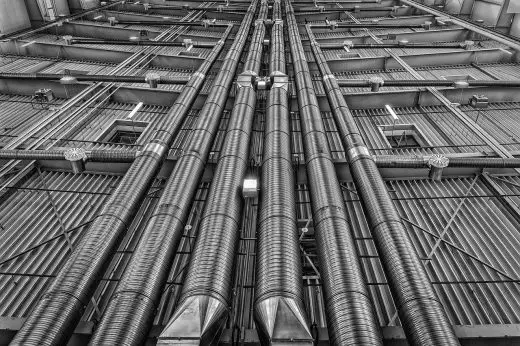What to Know About Air Conditioning Ducts Tips, Building Advice, Design Guide
What to Know About Air Conditioning Ducts? How It Works
Oct 9, 2020
Air conditioning ducts are conduits or ventilation used in heating. The air conditioning (HVAC) lets in and removes air in a room or a building.
What Needs to be Known about Air Conditioning Ducts and How It Works
The installation of ductwork is vital, and many people tend to overlook it. The ducts will ensure that the rooms, your home, and even commercial buildings are well heated during winter, cooled during summer, and the air is fresh all the time. No matter how small a room is, ensure that you install and change the ductwork system as often as required.
Functions of a Duct System
Ducts systems are designed to dispense airflow from your HVAC system to the whole building evenly. It involves the air being drawn from the whole room/ building and directed to an air conditioner. The air is then cooled or heated. It is later distributed back into your rooms via the ducts.
The duct’s efficiency will determine the intake and output of air. Therefore, ensure that the installation is done correctly to ensure that the air pressure, cooling, and heating systems performance are balanced.
Importance of Proper Installation
When ductwork is installed correctly, it will keep the whole house comfortable, distributing the temperature evenly around the house. Poor installation will bring several problems. For example, you may experience air leakages. It will make the whole system work inefficiently, and the air quality will be inferior. It may cause the entire air conditioning and the heating system to fail. It will add more cost when it comes to repairs.
For proper installation, ensure that the sizing of the ductwork is checked. The size of the ductwork should always match the size of your air conditioning and heaters. It will ensure that their performance is as efficient as possible. When your ductwork is done correctly by professionals, it will ensure the system has a long-lasting optimal efficiency. The duct will adequately distribute airflow to all the rooms in the house or the buildings.
Reasons you should Frequently Clean your Ductwork
It’s always vital to have quality air in your house. It will keep out pollen dust, pet hair, and any irritant from the air around the house. Contaminants usually accumulate in the duct system. Therefore, periodic cleaning is essential. The following are a few reasons to clean the ductwork frequently: Sometimes, ductwork could be clean by yourself, but if you aren’t sure about quality cleaning, you take a consultation from a reputed company like https://jlcoolingandheating.com/. Or you can hire a contractor from there.
Allergies and Dust
It helps protect your family and you from harmful dust and contaminants. Air ducts are ideal breeding grounds for bacteria, fungi, and other allergens. Young children and senior citizens are vulnerable and may contract allergies or even asthma. Therefore, it’s important to contact an air duct cleaning company to inspect your ducts on a yearly basis
Molds
Most air duct systems are installed in the basement of the house. The basement may be wet and damp or have cases of flooding. The moisture often causes mold to grow in and around the ductwork. After cleaning, ensure to put an anti-microbial into the duct system to prevent future growth of molds.
Efficiency
Dust, hair, pet hairs, among other pollutants in your ductwork, may hinder the air conditioning and heating system’s efficiency. Proper and frequent cleaning helps to remove dirt build-up. Regular cleaning will ensure there is adequate airflow that is required to run the system efficiently. You will also get a chance to remove insects like moths and termites that might be building up inside.
Cleaning the ductwork will ensure the motors and the fans are not overworked while distributing air to your house. It will reduce the number of repairs and services done to the air conditioning and heating system. It will ensure the quality of the air in your house is pure.
Materials Used to Make Ductwork
Aluminum
Ductwork made using aluminum is very light, which makes it very easy to install. Aluminum is easy to customize in unique shapes according to the site or the shop.
Galvanized Steel
They are the most popularly used materials to fabricate the ductwork. A zinc coating prevents metals from rusting. Therefore, you will cut on painting costs. The metal ducts will be lined with duct liners or wrapped with a duct wrap on the outside. In certain circumstances, a doubled-wall vent will be required.
Polyurethane and the Phenolic Panels
The form panel is made using a factory-made aluminum finish inside and outside. Aluminum foil thickness will vary depending on whether it’s used on the inside or outside.
Fiberglass Duct Boards
These types of panels are made for built-in thermal insulators. The interior surfaces absorb noise and provide quiet air conditioning and heating operation unit.
Flexible Ducts
The ducts are manufactured using flexible plastic covering metal wire coils that form a tube-like shape. These flexible ducts come in a large selection. They are very suitable for attaching air supply outlets to ductworks that are not easy to bend.
Components of Duct Systems
Apart from the duct itself, a duct system has several other parts. The parts work together with the vent to offer quality air conditioning to your entire house.
Vibration Isolator
They are placed in the duct before air handlers to reduce vibrations and noise when the system is in operation.
Take-Offs
They get fitted in the central duct walls’ opening cuts to aid in branching and let in small portions of flow in the branch ducts. They are numerous metal tabs bent and are attached to the central duct.
Volume Control Dampers
The duct systems require ways to regulate airflow magnitude to different sections of the unit. The dampers can be automated or manual.
Smoke and Fire Dampers
They are found in systems that pass through fire curtains and firewalls. They are designed to automatically seal the duct when they detect any smoke or fire. They stay sealed until manually opened by a technician.
Turning Vanes
They are placed in the ductworks to help minimize resistance and irregular motion to airflows. The air gets controlled by the vanes and can easily alter direction.
Air Terminals
It’s an outlet that helps supply and exhaust air. When it comes to air supply, you will find diffusers in small HVAC units mostly installed in residential housing. Grilles used for exhausting is only for appearances. However, some are fitted with air filters.
Inference
Quality air conditioning in your house or building is vital. Proper installation is critical, and you should ensure you get professionals to do it for you. They will help you evaluate and advise you accordingly on what you need. It will ensure you have an efficient and effective system only for appearances, although some are fitted with air filters.
Comments on this What to Know About Air Conditioning Ducts advice article are welcome.
Air Conditioners Articles
Air Conditioners Posts
What temperature should I set my air conditioner
5 great advice from top rated HVAC contractor
Building Design Articles
Comments / photos for the What to Know About Air Conditioning Ducts Guide page welcome


